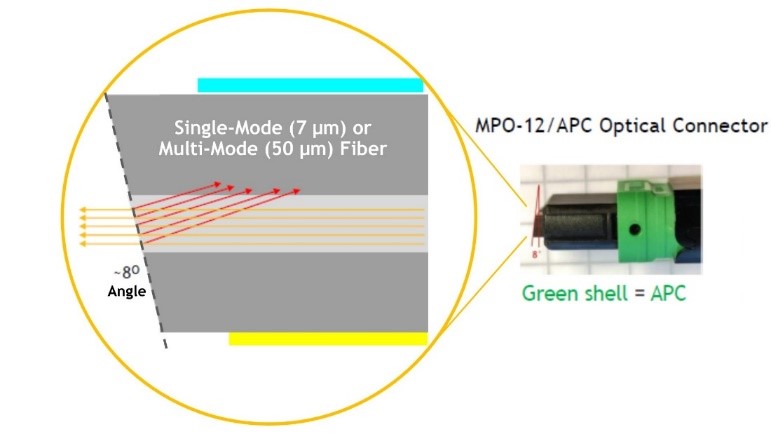Components#
NDR introduces new connector types for switches, cables, and adapters. It also introduces a new family of optical transceivers and MPO fiber cables.
NDR Switch Connectors (OSFP)#
Figure 13 shows the connector side of a QM9700, which is an air-cooled 64-port NDR switch.
Figure 13. QM9700 NDR switch
To fit 64 connections into one rack unit (1U, or 1RU), it uses 32 OSFP connectors and each physical connector provides dual NDR ports. The OSFP cages only accept ‘finned’ OSFP male connectors, to help cool such a dense array of ports.
NDR Cable Connectors#
NDR introduces two new connector form factors to InfiniBand: two variants of OSFP and QSFP112 (Quad Small Form Factor Pluggable, rated for 112 Gbps per lane), as shown in Figure 14.
Figure 14. NDR cable connectors
Figure 14 shows connectors on passive and active copper cables. Optical transceiver versions, which have MPO/APC connectors on the outboard end, are discussed in the next section.
The flat OSFP connector is single-port and is used for adapter connections. The finned OSFP version has ‘twin’ ports and is physically taller and is only used in switch ports.
QSFP112 connectors are single-port and are used for DPU connections where card edge space is limited.
The QSFP112 connector technology is also used for 400 GbE.
NDR Optical Transceivers#
Figure 15 compares the physical sizes and power requirements of InfiniBand transceivers. Note the height difference between the flat OSFP connector used for adapter ports and the taller finned OSFP connector used for NDR switch ports.
Figure 15. InfiniBand transceiver sizes
OSFP transceivers can support two standard MPO connections, with a pair of standard MPO connectors turned 90 degrees and mounted side by side, as shown in Figure 16. Flat OSFP transceivers, intended for NDR and NDR200 adapter ports, are single-port with the second port physically blocked.
Figure 16. OSFP twin-port transceiver
NDR MPO/APC Fiber#
The NDR transceiver family supports both single-mode and multi-mode passive fiber to provide a range of reach, cost, and power requirements. In most regards, NDR fiber cables are the same as those for HDR as described in Section 2.6. Unlike HDR, NDR fiber cables use MPO/APC (Angled Physical Contact or Angle Polish Connector) connectors, which provide superior signal integrity but do not interoperate with previous InfiniBand MPO cables.
Figure 17 illustrates the MPO/APC concept.
Figure 17. MPO APC concept
Fiber used in other connectors such as MPO/UPC have a polished end face that is perpendicular to the fiber axis. This end face acts as a mirror and reflects a portion of the laser beam back toward the transmitter (back scatter). This can reduce signal integrity and degrade the laser. MPO/APC uses fibers with a slightly angled face, so the reflected light is sent off-axis out of the fiber.
Minimum Bend Radius for NDR Cables#
As with previous InfiniBand media, NDR cables can be damaged or have their signal integrity degraded by bending them too sharply:
For DAC or ACC cables, the minimum bend radius at the connector itself is 70 mm (2.75 inches). Elsewhere in the cable the minimum radius is smaller: 34.5 mm (1.4 inches).
For fiber, whether single-mode or multi-mode, the minimum bend radius is 30 mm (1.2 inches).




